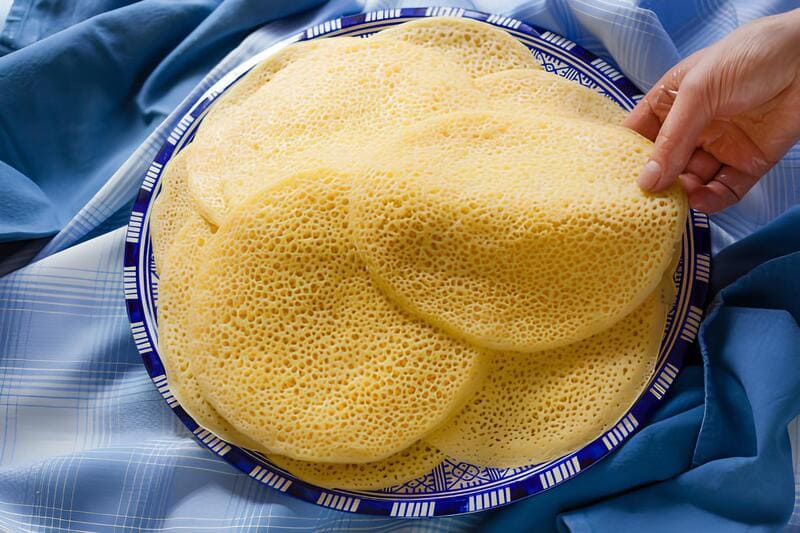
Baghrir, often referred to as Moroccan Crepes, are a beloved traditional dish in Morocco. Characterized by their unique porous texture, Baghrir absorb and hold onto toppings like honey, butter, or jam perfectly, making each bite a flavor explosion. Historically, these pancakes have been a staple breakfast or snack, shared among families and at festive gatherings.
Known also as “1000-hole pancakes” due to their spongy appearance, these crepes are distinct for their lightness and delicate taste. They’re particularly famous in Algeria and other North African countries as well, where slight variations may exist. Whether enjoyed with Moroccan tea or as a standalone treat, Baghrir captures the essence of North African culinary tradition.
Ingredients
- 2 cups semolina flour
- ½ cup fine white flour
- 1 tablespoon baking powder
- 1 teaspoon yeast powder
- 1 teaspoon salt (or to taste)
- 3 cups warm water
Preparation
- In a large mixing bowl, combine 2 cups of semolina flour, ½ cup of fine white flour, 1 tablespoon of baking powder, 1 teaspoon of yeast powder, and 1 teaspoon of salt.
- Measure out 3 cups of warm water using the same cup for consistency. Add this to the dry ingredients.
- Mix all ingredients just until combined. You can use an electric mixer or a grinder for about 1-2 minutes until the mixture is smooth and well-blended.
- Let the mixture rest for about 15 minutes to allow the dough to ferment.
- Preheat a non-stick frying pan over medium heat. Ensure the pan is thoroughly heated before starting.
- Pour a ladleful of the batter into the pan. Leave it to cook until bubbles form on the surface and the crepe is firm (about 1-3 minutes).
- Once the Baghrir is cooked, remove it from the pan and place it on a plate. Repeat with the remaining batter.
- Serve warm with honey, jam, or butter as per your preference. Enjoy your traditional Moroccan crepes!
Did you know?
Baghrir is not just a culinary delight but also a cultural symbol in Morocco and Algeria. The porous texture is achieved through a unique leavening process using a combination of yeast and baking powder, which creates the delicate holes that define Baghrir. These holes are essential as they help the crepe soak up the delicious toppings that are often rich and flavorful.
In different regions, variations of Baghrir exist, sometimes incorporating additional ingredients like anise seeds or saffron for a slight twist in flavor. While traditionally served with honey or butter, modern adaptations have seen Baghrir paired with both sweet and savory toppings, from almond paste to spiced meat fillings.
The traditional method of cooking Baghrir over a flat, clay griddle called a “makhla” is still practiced in rural areas, adding historical significance and an artisanal touch to each batch. What’s fascinating is that these crepes are also a sister treat to the Middle Eastern Khobz Al-Moftah, showcasing the rich, intertwined culinary heritage of the region.
So next time you enjoy these delightful, thousand-holed pancakes, remember you’re partaking in a bite-sized piece of Moroccan and Algerian history!
